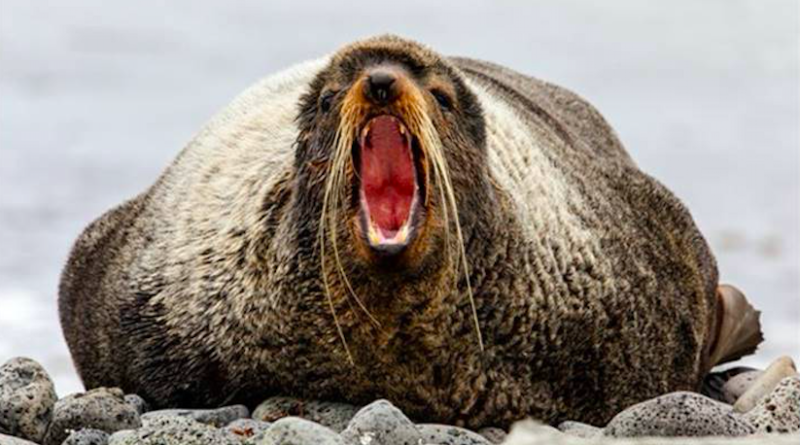INTERVIEW: Heading into the ‘Last Unknown’ of the Aleutian Islands
Photo: Ian Shive heads to the Aleutian Islands to film spectacular wildlife dramas. Photo courtesy of discovery+ / Provided with permission.
There’s remote, and then there’s the Aleutian Islands of Alaska’s coast.
These volcanic rocks, hanging off mainland Alaska like a reverse Cape Cod, are home to exquisite displays of unparalleled nature and jaw-dropping wildlife, but because of the difficulties in traveling to the islands, these sights are hard to access. Indigenous communities have called the island chain home for many, many generations, but the tucked-away landscapes are nearly impenetrable to visitors and researchers. Now discovery+, the new streaming service, is taking viewers into this unique setting, which is simultaneously paradisal and hellish, with a documentary called The Last Unknown.
The intrepid host for the streaming special is Ian Shive, acclaimed nature photographer and worldwide journeyman who never turns down a challenge, no matter how seemingly impossible. He joined researchers with the U.S. Fish and Wildlife Service, who were studying animal populations on the islands. “It is one of the most rugged places I’ve ever been,” Shive said in a recent phone interview. “I’ve been to 45 countries for environmental organizations over the last 16 years, and I’d say this one wins. You know, I think the hardest part of it is that … everything is unknown.”
First off, Shive and the crew needed take a ship into the choppy, dangerous waters of the Bering Sea. Their goal wasn’t to reenact Deadliest Catch, but rather to find an area where they could safely land their boat and jump ashore. Battling their vessel were Arctic-like winds and freezing conditions. There was a constant mist in the air and sometimes a driving rain. They needed to pull up to shore, but there were no docks anywhere to be seen. So they had to maneuver a skiff from the main boat while also wearing Arctic float suits.
“You have to cut through a moat of kelp, a seaweed that sort of protects the beach, so you don’t want to get caught in the swell and get tipped over into the ocean,” he said. “And if you make it to the beach, it’s not even a beach. There’s no sand. It’s just giant boulders that are slippery and waiting to break your ankle at every chance they can get, and then once you get across the boulders, and you move all of your gear onto the beach, there’s no trail. There’s certainly no resources, and the island is uninhabited. So now you’re going to hack your way in to see what is there and how is the wildlife doing. So I started in places like the national parks, and I’ll tell you this national wildlife refuge makes the national park look like a great vacation.”
However, there is cinematic gold at the end of the road on the Aleutian Islands. Shive and his crew were able to see the “greatest wildlife spectacles on Earth.” There were millions of seabirds that were migrating across the land and ocean. There were hundreds of thousands of northern fur seals that were fighting for territory and opportunities to mate. In the backdrop, one could capture steam, volcanoes, bubbling cauldrons and the blue of the ocean. And in that ocean? Endangered sea lions almost everywhere.
“It’s like going back in time where nature and wildlife were the rulers, and having a glimpse of a place that is so protected and so isolated that these stories continue to play out every day like that,” Shive said. “And so it’s a spectacle beyond words and absolutely mesmerizingly beautiful.”
There’s no rest for the weary though. Shive needed to not only jump ashore but also bring the necessary equipment in order to have the images he would need to produce The Last Unknown. He called the technology of the situation a “nightmare.”
Since a young age, Shive has always appreciated the behind-the-scenes dramas of nature documentaries. No doubt the environmental wonders amazed him, and the wildlife produced the requisite oohs and aahs. But he was taken in as a child with how the cinematographers got these breathtaking shots, and today he finds himself in a position to be that person with the camera.
“That process is so complex,” said the nature photographer, who has worked for the Nature Conservancy, Sierra Club, Environmental Defense Fund and National Parks Conservation Association. “You’re moving 400 pounds of gear sometimes and dealing with a camera that may cost $100,000 once it’s all put together with lenses and everything, and it’s pouring rain. And you’ve got a million seabirds that are letting loose above you and droppings on your camera and on your screen. Add to that salt water, which doesn’t exactly pair well with electronics. It’s excruciatingly difficult, and so the whole thing is about having processes. How do we get our gear in? What bag? What lens? What waterproof case is that camera going in? It’s a very, very rigorous process.”
He added: “A lot of times we’re climbing mountains or climbing cliff sides to get up there with this gear and then get these shots, which is the fun and the adventure of the show, but once you get there, then it really is rather calming. It’s sort of the eye of the storm, so to speak, because then you’ve got to get back. But once you’re actually there, and you’re in the colony of wildlife that you’re filming, it sort of unfolds before you and is almost a quiet, peaceful process.”
By John Soltes / Publisher / John@HollywoodSoapbox.com
The Last Unknown, featuring Ian Shive, is now streaming on discovery+, Discovery’s new streaming platform. Click here for more information.

